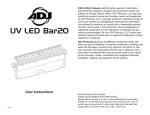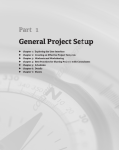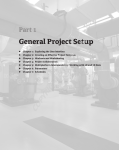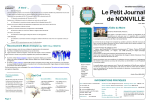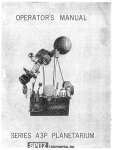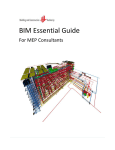Download CR4224 - BIM at the Heart of the MEP Subcontractor
Transcript
CR4224 - BIM at the Heart of the MEP Subcontractor Business Damien Legrand – BIM Solutions Centre Sophie Montenot – BYME Engineering Hub (Singapore) Class Description Dive into the heart of an MEP subcontractor business and experience the challenges and requirements associated with a BIM delivery process. See how they develop their internal strategies and processes to optimize the delivery process. Topics include implementing new workflows; bringing the engineers to the centre of the model; developing new methods to exchange information to facilitate the commissioning and procurement phases; and enabling a high level of coordination and QA for the duration of the project Key Learning Objectives At the end of this class, you will be able to: • • • • Analyze project requirements and develop a project BIM strategy accordingly Implement new workflows using the model as a core source of information Create a new range of deliverables to support internal and external processes Measure and monitor the overall efficiency of the process About the Speakers Damien Legrand Damien is a BIM business development consultant and owner of BIM Solutions Centre Ltd. He graduated (MEng) and worked as a bridge engineer in France before moving to the ANZ region. He has now specialized in BIM technology for the last six years and provided consulting services for a great range of industry professionals (architects, engineers and contractors). [email protected] Sophie Montenot Sophie Montenot is the MEP BIM Manager at BYME Engineering Hub Singapore, a subsidiary of Bouygues Construction Group. She graduated with a Master's degree in Engineering with honors and has worked as a mechanical engineer in France and China. Over the past two years she has developed a BIM department within BYME and has been involved in large scale projects in Doha and Singapore. [email protected] Insert Class Title as per Title Page Introduction With the constant development of BIM technologies over the past few years, we have seen a number of subcontractors become involved. With different requirements than designers and/or builders, this paper showcases some of the uses of the technology made by a multidiscipline MEP subcontractor working on a large scale project in Singapore. BYME (member of Bouygues Construction Group) Byme has been established in HK 20 years ago. B.Y.M.E stands for Bouygues, a global leader in construction, Yang, a local company and Mechanical and Electrical. BYME is experienced in all M&E trades including Electrical, Mechanical, Ventilation & Air-conditioning, Fire Services, Plumbing & Drainage, Building Management Systems and ELV Systems as well. BYME’s BIM experience by Sophie Montenot (MEP BIM Manager) “It’s only 2 years since our Engineering Hub based in Singapore decided to take the big step in BIM. Our first experience was on one of the biggest projects ever handled by our company: Qatar Petroleum District in Doha. Only 9 towers, an hotel, a prayer hall, an Energy Center etc... Some few millions square meters to model in 3D! A big challenge for us beginners in the BIM world! From that experience we have learnt a lot: how to manage our projects using BIM, how to implement a team and how to convince your management! We are now working on the Singapore Sports Hub where we have implemented a couple of processes to facilitate the exchange of information. The whole project is done in REVIT (structure, archi and MEP).” Problematic With the development of BIM technologies in recent years, the real challenge is for MEP subcontractors to use the new tools in an aim of producing a better and more coordinated set of drawings for the production team. This will save time, resources and reworking on site. While this may look simple on paper, in reality it is a very intricate exercise. First the MEP contractor needs to develop a series of internal process around the use of BIM technology to maximise the design optimisation and prepare the shop drawing for the production team. Secondly it needs to establish a number of relationships with the other parties involved in the project to ensure that the information required in step 1 is passed to him in a coordinated and timely manner, It is the complex combination of these two components that will impact on the overall benefit of using BIM technology. To illustrate the above problematic, the following document will take a close look at 4 project situations. For each of these we will examine at the technological solution developed and explore how the project environment impacted upon these solutions. 2 Insert Class Title as per Title Page Context and project The Singapore Sports hub 55,000 seat stadium for athletics, football, rugby, and cricket 3,000 seat multi-purpose indoor arena, 6,000 seat aquatic center 40,000m2 Retail Mall, 2-storey Office building, 4Storey Car Park, Sports Museum, Sports Library, and Water Sports Centre Integrated MRT station and many hectares of publicly accessible landscaping providing community sports and leisure activities Fig 1. The Singapore Sports Hub The role of the MEP sub contractor on this project In this case the MEP subcontractor has 3 teams working on the project: • • • The design team is in charge of working with the MEP consultant to optimise the design from a construction point of view. The result of this is a set of shop drawings and schedule of equipment that is then passed on to the production team. The procurement team works closely with the production team and the design team in order to buy the required equipment for the project. The production team is responsible for installing or to work with specialised subcontractors in fabricating and installing services. The MEP subcontractor is also in charge of the coordination of the services openings (CBW) with the main contractor Situation 1: What deliverables for what purpose? Context and project circumstances As described above the design team is in constant communication with the production team, the procumbent team and the general contractor. The contract specifies a number of formats for the project deliverables such as ACAD shop drawings, ACAD combined services drawing, Revit models, calculation notes and schedules of equipment. However it seems that maintaining a set of deliverable for its life cycle in one particular format is costly and time consuming. It is also a source of errors as some the information on the drawings is disconnected from the live BIM model. Therefore it is important to develop other mechanisms for exchange of information with other parties. 3 Insert Class Title as per Title Page Ex 1 Generating CSD drawing in Revit Contractually BYME owes the MEP consultant the CSD drawings in an ACAD format. Practically these drawings are used for review and approval by the consultant. They get marked up and commented upon but there is no real need to edit or modify them directly. In this situation there was a compromise with the consultant that all drawings would be kept in Revit until approved and that only the “For Construction” issue would be converted to ACAD. During the modelling phase, a single Revit model was generated. This model uses Worksets to allow all trades to model their services into one single model. The display of information on views (both plan and 3D) is control by filters. This provides visual guidance to the coordinators when they eliminate the various clashes. Fig 2. Workset settings Fig 3. Fig 4. 4 Extract of the stadium MEP model Filters and colour coding Insert Class Title as per Title Page At the end of the coordination, a plan view of the model is generated. This layout will be the base of the CSD drawings. The drawings then get annotated with tags and main dimensions. A few sections are also produced in parallel to go with the main floor plan. At this stage Autodesk Revit reaches its limitations. There are a number of visual problems that we cannot directly solve into the main view. The workaround developed takes 3 steps Step 1 Finalise the plan view • • Apply the CSD view template to control the displays of all elements, Note: the view display setting is a hidden line to show the dash line of services underneath Fig 5. Extract of the CSD floor plan view Step 2 Create the centre line overlay Duplicate the Main CSD view Turn off the visibility of all objects except pipes • Change the detail level to “coarse” Overwrite the pipe settings to centreline Fig 6. Pipe centre line isolated in a separate view Step 3 Create the assembly on the drawing sheet Fig 7. 5 Example of Revit drawing combining several views on the same sheet Insert Class Title as per Title Page This process is quite efficient because it allows the drawing to be revised quickly. It makes even more sense in a project of this size with more than 168 CSD drawings for the stadium alone. Ex 2 Converting a CSD drawing to ACAD The conversion to ACAD is a delicate exercise. It has definitely improved over time with the newer version of Revit but it still has issues. The main issue comes from the ACAD layer standard with which the drawing must comply. Fig 8. Extract of the BYME ACAD layering system Therefore the solution is to use a colour coding system in Revit. One unique colour in Revit will correspond to one ACAD layer. To perform manually, this process is extremely heavy and time consuming for a very small added value. To be able to reassign all objects to their correct layer in ACAD, the same view needs to be exported 7 times with different settings a. b. c. d. Export model objects (equipment + touting systems Export Centre lines for Pipes Export hidden lines for services shown under Export the annotations (4 times) to spate the tags from a trade to another) Only then it is possible to separate all objects and reassign the appropriate layer. The Revit API can come to the rescue with the ability to automatically generate a number of views and apply some specific view templates before exporting these views individually to ACAD. Fig 10. Fig 9. 6 Export to ACAD macro interface Indicidual views exported automatically Insert Class Title as per Title Page An AutoCAD macro then recombines the drawings and reassigns the object to their correct layer. Summary Even with a strong technical solution at hand it still requires good project management and communication skills to benefit fully from this BIM process. So don’t be afraid to talk to the third parties you are working with. It is frequently a case of everyone benefiting but too often it is assumed impossible because it was not in the contract. Ex 3 Other Revit deliverables FRAMING MODEL REFERENCE ARCHI MODEL REFERENCE SPORTS HUB SINGAPORE REF01-20110812 3D CONFLICT IDENTIFICATION ZONE SUB-ZONE LEVEL GRIDLINES IMPACTED TRADES (ST, AR, MEP) NST NS1 1 Case A: N13-N14 Architectural Case B: N14-N16 S1_NST_00_L2_Above_Framing_RVT_REV04 A2_NST_00_Lower Levels_RVT_REV03 (DSP-TRANSMIT-000696) (DSP-TRANSMIT-000660) A. Warm Up Room (Grid N13-N14) Fig 11. 7 Example of an RFI form Insert Class Title as per Title Page Situation 2: MEP spatial coordination Context and project circumstances In this particular situation the MEP subcontractor covers all trade and is therefore in charge of the coordination. In other situations the general contractor plays that role via a MED design management team that works with all the MEP subcontractors. In both approaches the principle and the end goal is the same Solutions implemented In order to develop a robust solution for the coordination problem it is important to understand all the factors impacting on it. The architectural and structural information In large projects like the Sports Hub it is important to make sure that the MEP coordination is performed using the latest architectural and structural models. Because the project is divided into zones (for example 4 zones for the stadium itself) it may mean that you need more than one architectural and one structural model at the time Fig 12. Revit Model document control matrix The MEP model Before starting any clash detection, it is important to assess the overall quality of the MEP model. 8 Insert Class Title as per Title Page Fig 13. Example of a precoordination test report The Clash detection and resolution The clash detection is performed in two steps: Step 1: clash detection in Navisworks performed for the entire model. A clash report is generated and used by the coordinators as a guide. Fig 14. 9 Navisworks clash summary Fig 15. Extract of the Navisworks clash report Insert Class Title as per Title Page Step 2: detailed clash detection directly in the Revit model. Note the interference check tool is not used. The check is performed visually with the help of sections and colour coding. Generally the number of clashes is counted in thousands. If we were to resolve every single clash it would take a considerable amount of time. Therefore it is important to set some priorities in the resolution of clashes. Situation 3: Services Opening (CBW) Context and project circumstances The problem of services openings and their coordination with the structure and architecture is always an important part of the project coordination. On one side the MEP designers are relying on the structural engineer and the architect to get approval or rejection on its opening requests, this decision being made from a design feasibility point of view. On the other side the construction program is constantly requesting the position and size of these openings to keep site activities on schedule. Stuck in-between the MEP designer needs a robust way to manage this flow of information between all these parties. Solution implemented To address this issue we developed an opening object with a certain number of parameters that enabled us to identify its origin and track its progress throughout the validation process. The opening family is a faced based componenf. Note the parameters in the data section. These parameters are used to track the status of the opening during the validation process. Then we implemented the request / validation workflow. Even if we were not able to guarantee that all openings were validated before the construction started at least we could capture the status of all openings and communicate them to the site teams. Fig 16. CBW family (Flag) Fig 17. CBW parameters As part of the preparation for a services opening coordination meeting, the coordination team collected information from all parties, the openings model from the MEP subcontractors, and the latest architectural and structural models. They then generated the combined model with the schedule of all the requested openings to be discussed during the meeting. 10 Insert Class Title as per Title Page Fig 18. CBW, Archtectural and Structural Models Fig 19. Combined model and CBW schedule During the coordination meeting we were not able to capture the live information digitally. We had to revert to a manual way to collect answers and decisions made on the openings request. The final result of the meeting was a marked up set of drawings which for each opening told us if it had been rejected, approved or not considered. The opening model then got updated accordingly. Fig 21. Fig 20. CBW table marked up during coordination meeting CBW table updated and colour coded in the CBW Revit model before issue Note the colour coding system used to quickly visualise the newly defined opening status. The same colour coding was applied automatically to the object in the model. Fig 22. Updated status of the CBW requests The opening model was then returned to the MEP subcontractor and at the same time to the concrete shop drawing contractor. The process was repeated weekly. In theory the process was working well. However we encountered some problems due mainly to a lack communication between parties. Some people experiencing project pressure thought that they had no 11 Insert Class Title as per Title Page option other than to revert to more traditional ways of dealing with this (i.e. overlaying ACAD drawing). This happened even after we fully documented the procedures. This created a significant risk to the integrity of the process as we began to have different flows of information running in parallel. This situation was a good example of a time where technically we were able to provide a robust solution to the identified issue but where we nearly failed due to an additional factor, that of a lack of communication. Situation 4: Review of Model Contents Context and project circumstances While the model is being developed, it is important that the information contained in the model is reviewed and validated. In a traditional process an engineer will wait for the 2d drawings to be produced and then mark it up. However, this process is too heavy to manage and too time consuming. Therefore it is important to enable the review of the model content before the final drawing is produced. The main difficulty is that the reviewers (engineers and trade managers) are not always familiar with the BIM technology and software. With the classic output such as the DWFx, Navisworks or even 3D pdfs reviewers can visually check the model. But when it comes to querying the engineering values of the different systems it becomes a little more difficult. In this case we are looking at checking the pressure drop in AC systems. Once again the API offers great help with the ability to quickly generate on demand reports that can be reviewed on screen or quickly turned into pdfs. Viewing the pressure drop of a single element This function allows the user to query one by one the pressure drop value in the part of a system. 12 Select an object On the addin tab, select External tools and pressure drop macro Read the pressure drop value on screen Insert Class Title as per Title Page Update multiple elements pressure drop tag In order to show the pressure drop value in a calculation note report, we need to copy the pressure drop value to the comment parameter. Select Multiple object part of an air system Read the validation message Tagging the pressure drop in a plan view As the list of deliverables is quite large and delivery dates span across a significant period of time, you can generate partial planning for a desired period of time. Go to a mechanical plan view and crop it to the system you are currently working on. In the annotate tab, select Select one by one the element of the system and arrange your tags in the view Fig 23. Pressure Drop macro user manual Conclusion In summary it is very important to remember that the technology has not been designed to resolve problems by itself. The most productive way to maximise the return on investment is to be able to tighten your internal BIM process with some operational project processes. This is not an easy task and it varies from project to project. From a strictly MEP point of view, it is true to say that Revit is not perfectly adapted to what we do. It has its benefits and its disadvantages. Yet sometimes small in-house developments can eliminate some key problems or automate lengthy tasks. Overall it is a constant challenge to make the best use of the technology in the ever changing and evolving project environment. 13













